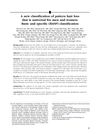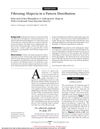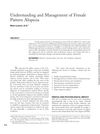Frequency of Types of Alopecia in a Single-Center Hair Referral Clinic Over a Ten-Year Period
January 2025
in “
International Journal of Trichology
”

TLDR Pattern hair loss is the most common type of alopecia.
The study conducted at the Center for Dermatology and Hair Diseases Professor Trüeb over 10 years included 15,211 patients and found that pattern hair loss (PHL) was the most common type of alopecia (67%), followed by alopecia areata (11%), cicatricial alopecias (11%), and telogen effluvium (7%). The study highlighted the need for a comprehensive classification of PHL beyond existing models. It also detailed the specific presentations of alopecia areata and cicatricial alopecias, noting the increasing importance of frontal fibrosing alopecia and fibrosing alopecia in a pattern distribution. Gender and ethnic differences were observed, with certain types of alopecia more prevalent in women and others in men, particularly among patients of African origin. Pediatric alopecia accounted for 2.4% of cases, with alopecia areata being the most common. The study emphasizes the value of long-term, single-center studies for understanding alopecia's epidemiology and clinical specifics.













